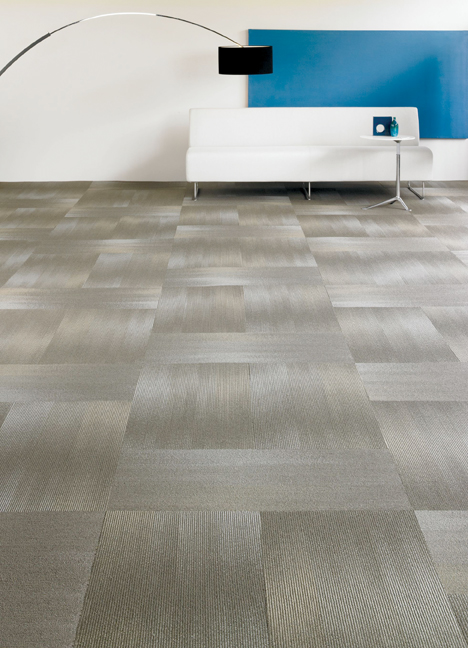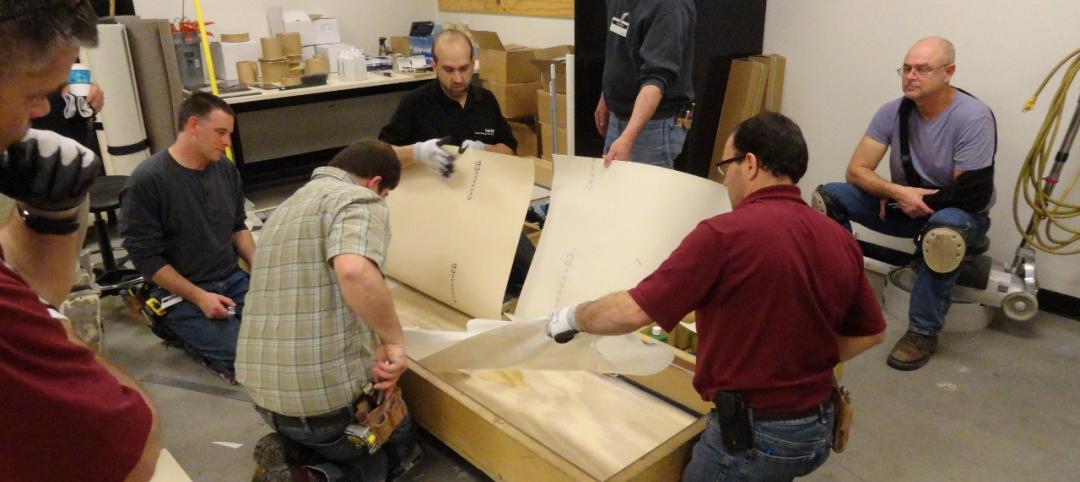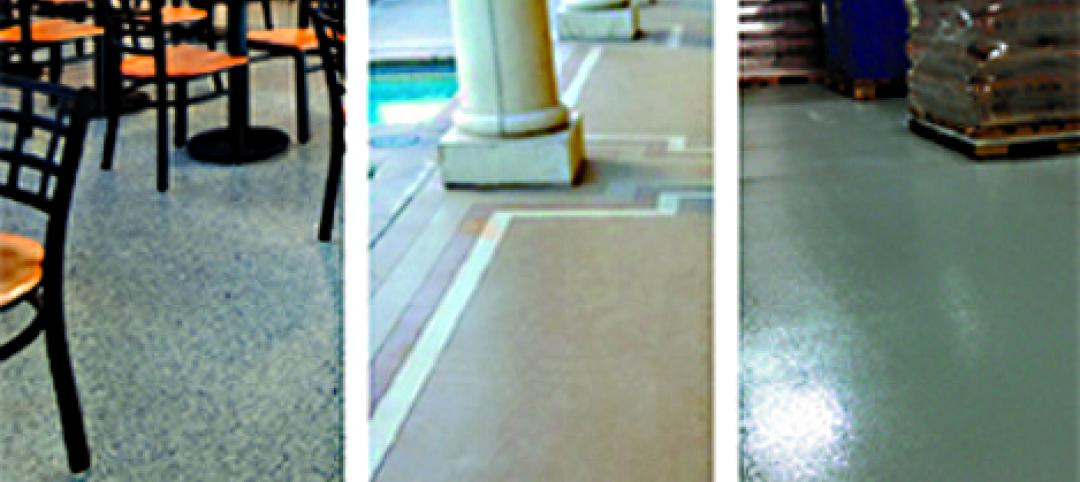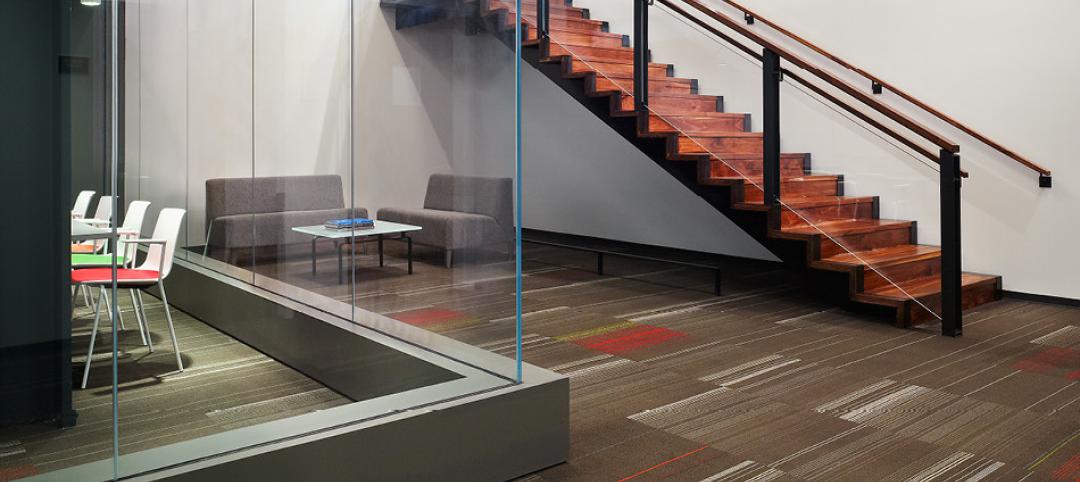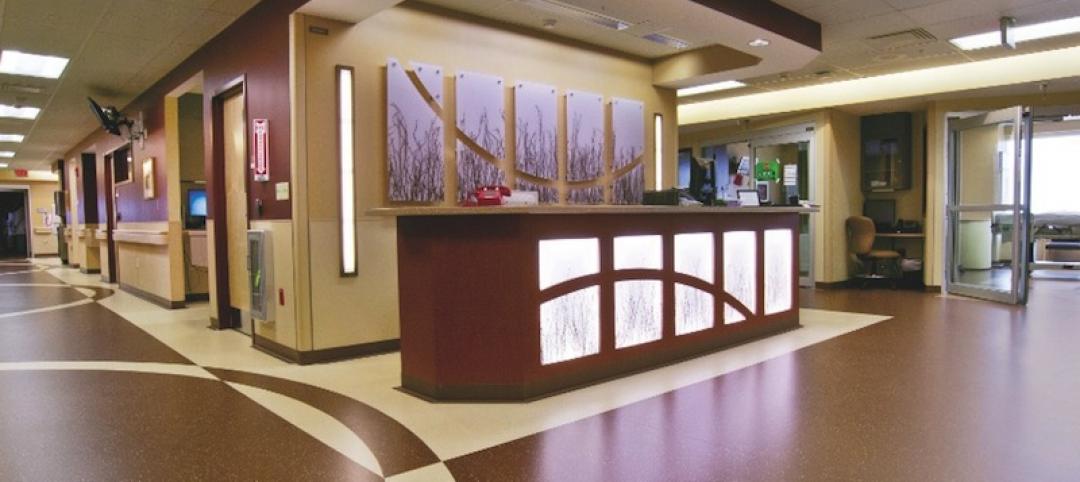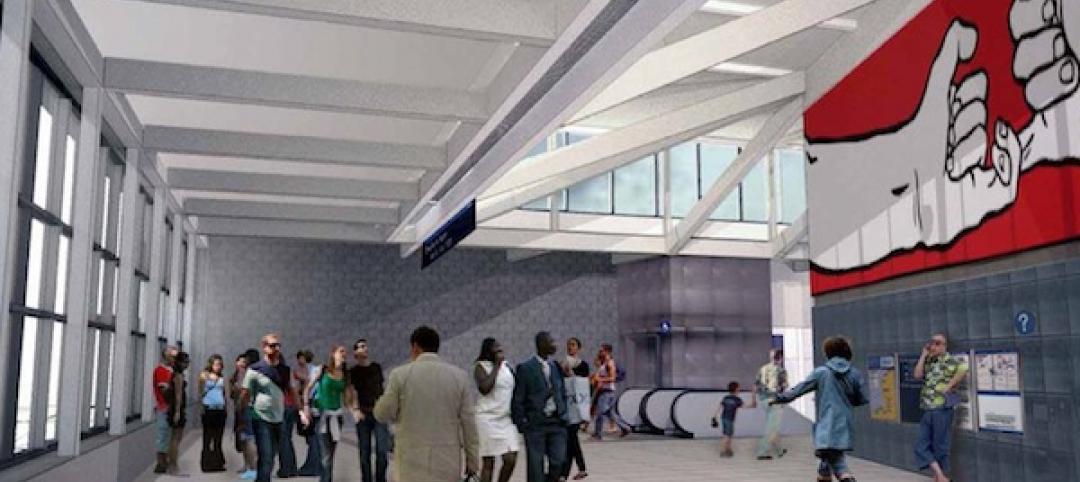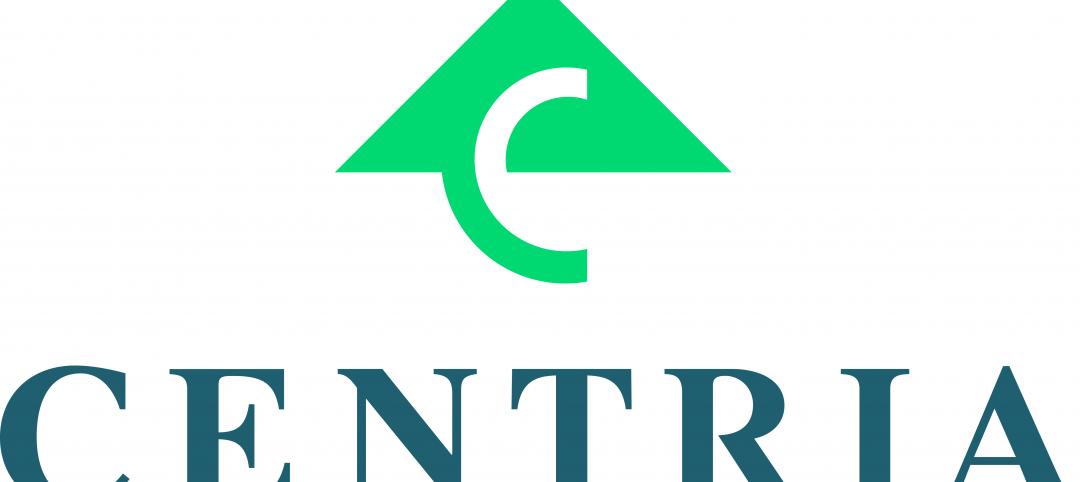When it comes to floor coverings, Building Teams can select from a broad menu of products, including carpet, polished concrete, and resilient surfaces like cork, linoleum, rubber, and vinyl. In the last few years, however, luxury vinyl tile (LVT) and carpet tile have been carving out a bigger chunk of the nonresidential flooring market, especially against broadloom products. Proven performance, ease of maintenance, and design innovations are adding to their appeal for use in schools and offices, and they are making inroads into nontraditional sectors like healthcare as well.
Dean Thompson, executive director of the Resilient Floor Covering Institute, says resilient flooring has gained market share over the last several years. “In 2003, resilient flooring comprised 13.8% of the market,” Thompson says. “Now it’s up to 19%. LVT, in particular, is capturing some share from more high-cost, labor-intensive categories like ceramic and stone.”
Last year, for example, Shaw Contract Group formed a partnership with LG Hausys to distribute LG’s resilient products. The reason was easy to understand: “The LVT segment has been growing,” says Reesie Duncan, creative director for the group.
Advances in printing technologies, Thompson says, “are bringing great new organic-type visuals to the products.” For example, some LVT products can now simulate grout lines, tumbled edges, and other details that mimic natural stone.
Sustainability remains the overarching theme with commercial flooring. FloorScore, a green rating system for floor coverings, was developed by RFCI and Scientific Certification Systems (SCS) to test and certify flooring products for compliance with indoor air quality emission requirements adopted in California. A year ago, a new ANSI standard for resilient flooring was released. As a result of these developments, manufacturers have been eager to certify their products and introduce recycling programs.
Designers are responding to the industry’s sustainability message. “We really try to go with the greenest alternative with any type of flooring,” says Kristen Beighey, LEED AP, an interior designer in the Dallas office of Perkins+Will. Beighey says the firm had been specifying a lot of vinyl composition tile (VCT), but recently switched over to Armstrong’s Biobased Tile, which is made with rapidly renewable, U.S.-grown plant materials and emits a low level of volatile organic compounds.
“A few years ago, the resilient industry was focused on a single attribute: indoor air quality,” Thompson says. “Now, like other industries such as furniture and wall coverings, we’re moving toward more full-fledged, life cycle-assessment thinking.”
Out with the rug, in with the tile
Like many in the flooring industry, Shaw’s Duncan is enthusiastic about the growth potential of carpet tile. In 2008, carpet tile represented only 40% of Shaw Contract Group’s annual sales; last year, carpet tile weighed in at 60%. “As the price of carpet tile becomes more competitive and manufacturers are pushed to look at the minimum amount of material they put into their products, tile has become the commercial carpet of choice in the architect’s and designer’s world,” says Duncan.
Duncan says the ease of installation, elimination of downtime in the workplace, and creative freedom offered by carpet tile has made it the number one flooring choice in the corporate sector. It’s been an especially big hit with multinational corporations, in part because it’s easier to ship than broadloom.
Product innovation over the last three years has allowed designers to mix patterns and colors in creative ways, says Duncan. With office layouts being defined less and less by walls and partitions, flooring can be used to delineate collaborative workspaces and add punches of color to raise the energy level of office workers.
Another sector where carpet tile is gaining attention is education, especially the K-12 market. “Maintenance is usually the biggest factor for schools,” Duncan says. “They need something that’s easy to clean. If there’s a stain that won’t come out, they can just replace the tile.”
LVT broadens its scope
Meanwhile, LVT is expanding beyond its traditional use in retail to reach into healthcare and education. Julia Pierce, director of commercial product marketing and design for Armstrong, says hospitals and clinics centers are mixing and matching LVT designs in lobbies, while schools are putting down wood-look LVT in the corridors. “It looks less institutional,” says Pierce.
RFCI’s Thompson also notes that the healthcare and education sectors have remained active. “Resilient flooring penetrates at a higher level in those segments than in some of the other categories, just because of the end uses,” he says. “There are a lot of high-performance, active areas that need the advantages of a resilient floor.” Manufacturers have improved the finish levels of resilient flooring to reduce the amount of required maintenance.
For the renovation of the Medical Center of Plano, Texas, Perkins + Will’s Beighley specified LVT flooring because “it holds up well in the healthcare environment,” she says. “It’s a no-wax floor, so it’s easy to maintain.”
But there is also potential for growth in nontraditional floor coverings such as quartz tile. The Miraton line from Hanwha Surfaces was recently installed in the Atlanta Hartsfield-Jackson Airport terminals because of its durability and numerous color options, says Lisa Herreth, product designer and marketing specialist for Hanwha. Several color options in the Miraton line are made up of recycled components and are SCS-certified.
Herreth notes that floor tiles are finding new uses and are even moving up the walls. “Thinner floor tiles are being manufactured for application to walls and vertical surfaces, creating a cohesive, seamless design,” she says. BD+C
Check slab for moisture before installing the flooring Would you rather pay $2,500 to pre-test your building’s concrete slab for moisture, or spend hundreds of thousands of dollars to replace the flooring when it starts blistering and peeling away? Unfortunately, many developers, architects, and contractors skip the testing and take their chances, says Lee Eliseian, founder and CEO of Independent Floor Testing & Inspection (IFTI) in Concord, Calif. Only after suffering through a flooring or coating failure do they adopt the practice of pre-installation moisture testing, he says. IFTI tests interior concrete slabs for moisture prior to the installation of floor coverings or coatings. “We do an analysis and report on the conditions of the slab and how it could affect the moisture-sensitive finishes that will be installed,” he says. “We also provide a forensic service after a flooring failure, to get at the root cause of the problem.” Problems usually become apparent within months after the floor covering or coating is installed. The flooring doesn’t stay bonded to the concrete substrate and may start to breach, allowing cleaning solution to seep underneath and worsen the damage. “Imagine the cost to a hospital that has to shut down an operating room in order to fix a slab moisture problem and replace the newly installed flooring,” says Eliseian. Slab pre-testing can give retailers an edge when they’re moving into buildings that have been vacated by other tenants. “We come in as part of a due diligence process during the lease negotiation, to get a good benchmark of what the slab moisture conditions are,” he says. “If adverse conditions are identified, they can decide early on who is going to shoulder the cost of slab moisture mitigation.” |
Rubber Flooring Rules in Nebraska Hospital There was no question that Doris Witte, EDAC, NCIDQ, senior interior designer for HDR Architecture in Omaha, Neb., would use rubber flooring for the Nebraska Medical Center’s adult intensive-care unit. “It’s one of the hospital’s standards,” says Witte, who selected several nora products for the project. Two colors of noraplan environcare sheet product, cut into a larger oval, were used in patient rooms, while darker, solid oval strips of norament strada were used in the corridors. “We wanted to highlight the nursing modules to visually shorten and break up the length of the corridor, so we used an oval inset with the strada product,” she says. Rubber flooring was chosen for its functionality as well as its beauty. “With rubber, you get better acoustical control than you do with some of the other sheet goods on the market,” Witte says. “And the biggest draw is that you can just polish it. You never have to strip off wax and re-wax it. So the life cycle cost of rubber flooring goes down the longer it’s in use.” |
Related Stories
| Mar 12, 2014
nora Technical Academy Certifies 1,400 Installers and Counting
Program marks six years of hands-on installation training with 2014 class schedule
| Mar 5, 2014
5 tile design trends for 2014
Beveled, geometric, and high-tech patterns are among the hot ceramic tile trends, say tile design experts.
| Jan 21, 2014
Dur-A-Flex’s New Accelera Fast Track Flooring System Helps Contractors Increase Efficiency, Profitability and Allows Facility Owners to Minimize Downtime
Dur-A-Flex, Inc., a leading manufacturer of commercial, industrial and institutional seamless, resinous flooring, has released Accelera Fast Track Flooring, the newest in its lineup of performance systems.
| Jun 19, 2013
NSF Sustainability begins verifying EPDs that can be used for LEED V4
NSF Sustainability has verified Environmental Product Declarations (EPDs) for nylon carpet styles and colors manufactured by Mannington Commercial and for J+J Flooring Group’s Kinetex® flooring product and Invision brand modular styles that use eKo® backing.
| May 21, 2013
7 tile trends for 2013: Touch-sensitive glazes, metallic tones among top styles
Tile of Spain consultant and ceramic tile expert Ryan Fasan presented his "What's Trending in Tile" roundup at the Coverings 2013 show in Atlanta earlier this month. Here's an overview of Fasan's emerging tile trends for 2013.
| Mar 23, 2013
A warm welcome at Roswell Park Cancer Institute
The Roswell Park Cancer Institute (RPCI) in Buffalo, N.Y., is the only upstate New York facility to hold the National Cancer Center Institute designation of “comprehensive cancer center” and to serve as a member of the prestigious National Comprehensive Cancer Network.
| Feb 28, 2013
Lend Lease builds world's tallest timber apartment building
Construction giant Lend Lease recently put the finishing touches on Forté, a 10-story apartment complex in Melbourne, Australia's Victoria Harbour that was built entirely with cross laminated timber (CTL) technology.
| Feb 25, 2013
Turner employs rare 'collapsible' steel truss system at Seattle light rail station
To speed construction of the $110 million Capitol Hill Station light-rail station in Seattle, general contractor Turner Construction will use an unusual temporary framing method for the project's underground spaces.
| Feb 21, 2013
Long-tenured Centria employee receives promotion
H.H. Robertson Floor Systems, a CENTRIA company, is pleased to announce the promotion of Kevin Daily to leader of the division. Daily, a 40-year veteran with CENTRIA, replaces former leader, Al Smith, who retired after 51 years with the company.
| Jan 30, 2013
New polling feature encourages member feedback in the noraXchange, nora flooring’s online community
Honoring its commitment to connect with facility managers, architects, designers, installers, other building professionals and key decision makers in meaningful ways, nora® flooring has introduced a polling feature to noraXchange, the interactive online community hosted by nora systems, Inc. The noraXchange provides customers with information that addresses the challenges and questions they regularly encounter in their work.


